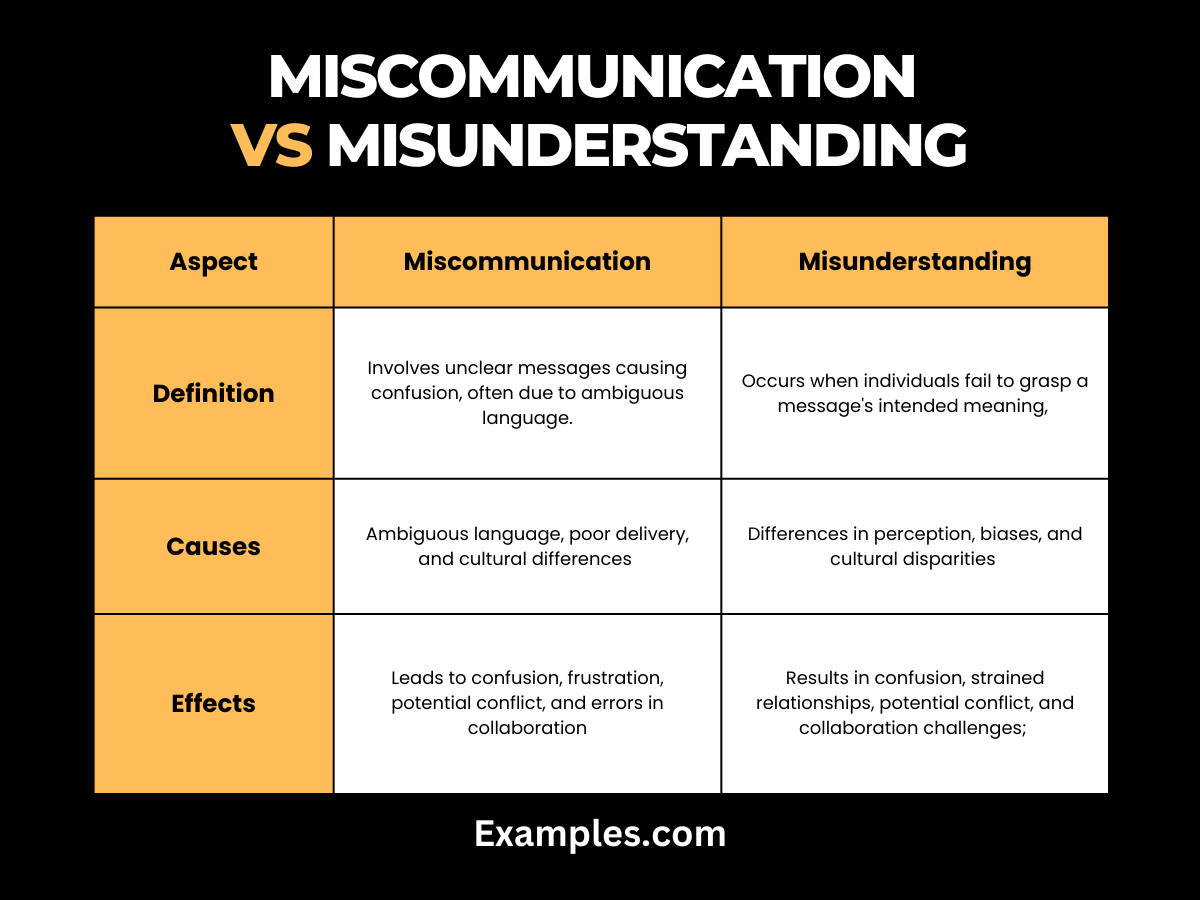Miscommunication vs Misunderstanding – Examples
Embark on a journey to unravel the intricacies of Miscommunication vs. Misunderstanding in this comprehensive guide. Explore vivid Communication Examples that illuminate the distinctions, offering insights and practical tips for effective communication. Navigate through real-life scenarios, enhancing your ability to foster clearer, more meaningful connections in diverse situations. Enhance your communication skills and foster understanding with this insightful exploration of common pitfalls and their remedies.
Difference between Miscommunication and Misunderstanding
This comprehensive guide explores the intricacies of miscommunication and misunderstanding, offering insights into their definitions, causes, effects, prevention strategies, and real-world examples.

| Aspect | Miscommunication | Misunderstanding |
|---|---|---|
| Definition | Involves the transmission of unclear or distorted messages, leading to confusion or misinterpretation. This breakdown in communication can stem from ambiguous language, poor delivery, noise in communication channels, cultural differences, and misinterpreted nonverbal cues. | Occurs when individuals fail to grasp the intended meaning of a message, resulting in confusion or misinterpretation. Misunderstandings often arise from differences in perception, cognitive biases, cultural disparities, and inadequate context for message comprehension. |
| Causes | Miscommunication can be caused by ambiguous language, poor delivery, noise in communication channels, cultural differences, and misinterpreted nonverbal cues. These factors contribute to a breakdown in communication, leading to confusion, frustration, potential conflict, and errors in collaboration. | Misunderstandings are rooted in differences in perception, cognitive biases, cultural disparities, and inadequate context for message comprehension. These factors result in confusion, strained relationships, potential conflict, and challenges in effective collaboration. |
| Effects | The effects of miscommunication include confusion, frustration, potential conflict, and a breakdown in communication. When messages are unclear or distorted, it can lead to errors in understanding, strained relationships, and hinder effective collaboration. | Misunderstandings can result in confusion, strained relationships, potential conflict, and challenges in collaboration. Failing to grasp the intended meaning of a message may lead to misinterpretations and misaligned expectations. |
| Prevention and Resolution | To prevent miscommunication, it is essential to clarify messages, use precise language, practice active listening, establish feedback loops, and be aware of cultural nuances. Resolving miscommunication involves fostering an environment of open communication and addressing the root causes. | Preventing misunderstandings requires encouraging open communication, seeking clarification, practicing active listening, and fostering an environment of understanding and empathy. Addressing differences in perception and providing adequate context are key to resolution. |
| Examples | 1. Receiving an email with unclear instructions, leading to errors in task execution. 2. Ambiguous project guidelines causing confusion among team members. 3. Nonverbal cues being misinterpreted in a cross-cultural setting, resulting in misunderstandings. | Misinterpreting a colleague’s feedback during a meeting, leading to misaligned expectations. 2. Assuming the meaning of a message without seeking clarification, causing confusion. 3. Failing to understand the context of a humorous remark, leading to unintentional offense. |
Comparison Between Miscommunication and Misunderstanding
Miscommunication involves the transmission of unclear or distorted messages, leading to confusion or misinterpretation. In contrast, misunderstanding occurs when individuals fail to grasp the intended meaning of a message, resulting in confusion or misinterpretation.
- Origins: Miscommunication originates from ambiguous language, poor delivery, cultural nuances, and misinterpretation of nonverbal cues. Misunderstanding arises due to perceptual differences, cognitive biases, cultural disparities, and contextual gaps.
- Impacts: Miscommunication yields confusion, frustration, potential conflict, and communication breakdowns. Misunderstanding results in confusion, strained relationships, potential conflict, and collaboration challenges.
- Mitigation Strategies: Preventing miscommunication involves clarifying messages, using precise language, active listening, and cultural awareness. Addressing misunderstanding requires open communication, seeking clarification, active listening, and fostering understanding.
- Illustrative Instances: Miscommunication instances include unclear email instructions, ambiguous project guidelines, and misinterpreted nonverbal cues. Misunderstanding examples encompass misinterpreting feedback, assuming meanings without clarification, and misunderstanding humorous contexts.
- Navigating Communication Complexity: Understanding the nuances between miscommunication and misunderstanding is pivotal for cultivating effective and harmonious communication.
Relation Between Miscommunication and Misunderstanding
Miscommunication and misunderstanding, though interrelated, are distinct phenomena within the intricate tapestry of communication dynamics.
- Common Threads: Both stem from breakdowns in conveying and interpreting messages, leading to confusion, conflict, and relational strains.
- Shared Causes: Ambiguous language, cultural differences, and nonverbal misinterpretations contribute to both miscommunication and misunderstanding.
- Divergent Origins: Miscommunication often results from unclear delivery or noise in communication channels, while misunderstanding may arise from cognitive biases, inadequate context, or perceptual differences.
- Resolving the Tangle: To navigate the entwined nature of miscommunication and misunderstanding, fostering open communication, active listening, and cultural awareness is paramount.
- Strategies for Clarity: Implementing strategies such as precise language, feedback loops, and seeking clarification plays a pivotal role in untangling the web of miscommunication and misunderstanding.
- Real-world Context: Illustrative examples in everyday scenarios shed light on the nuanced relationship between miscommunication and misunderstanding, providing insights for effective communication strategies.
- The Harmony of Clear Communication: Understanding the intricate dance between miscommunication and misunderstanding is key to fostering clarity, harmony, and meaningful connections in the diverse landscape of human interaction.
Navigating the complex interplay of miscommunication and misunderstanding is paramount for fostering effective communication. Recognizing their distinctions and commonalities, implementing preventive measures, and embracing clarity contribute to harmonious interactions. Real-world examples illuminate the importance of untangling these intricacies, empowering individuals to navigate the delicate nuances of communication successfully.



